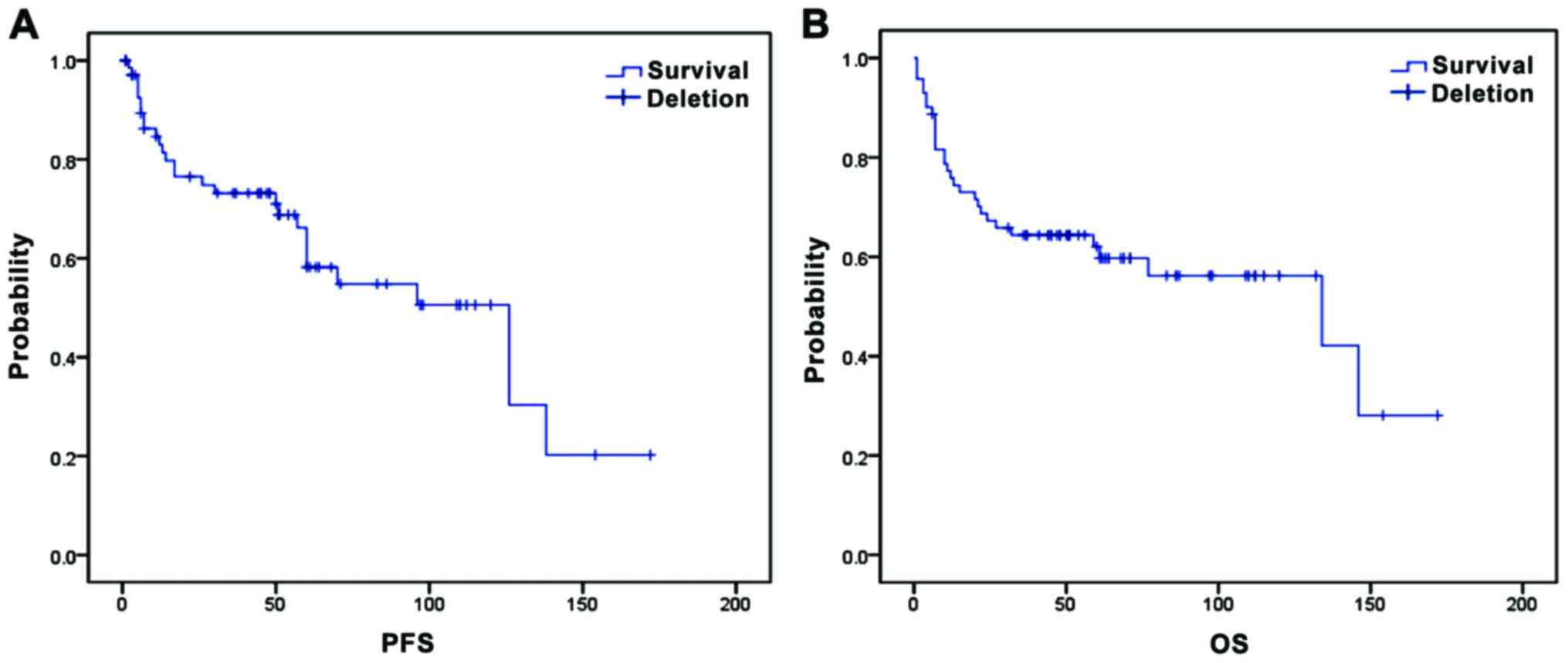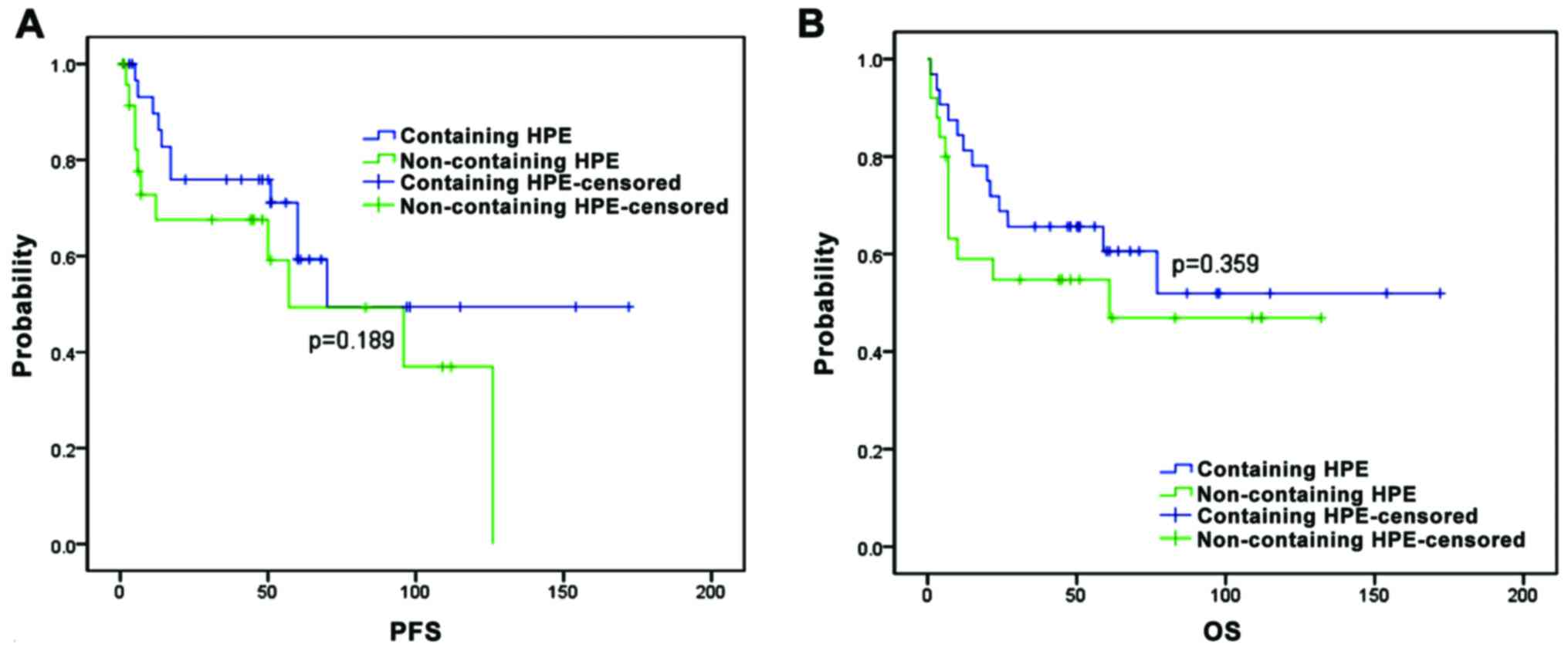|
1
|
Tomonaga M: Outline and direction of
revised WHO classification of tumors of haematopoietic and lymphoid
tissues. Rinsho Ketsueki. 50:1401–1406. 2009.(In Japanese).
PubMed/NCBI
|
|
2
|
Nakamura S, Ye H, Bacon CM, Goatly A, Liu
H, Kerr L, Banham AH, Streubel B, Yao T, Tsuneyoshi M, et al:
Translocations involving the immunoglobulin heavy chain gene locus
predict better survival in gastric diffuse large B-cell lymphoma.
Clin Cancer Res. 14:3002–3010. 2008. View Article : Google Scholar : PubMed/NCBI
|
|
3
|
Yoshino T, Omonishi K, Kobayashi K,
Mannami T, Okada H, Mizuno M, Yamadori I, Kondo E and Akagi T:
Clinicopathological features of gastric mucosa associated lymphoid
tissue (MALT) lymphomas: high grade transformation and comparison
with diffuse large B cell lymphomas without MALT lymphoma features.
J Clin Pathol. 53:187–190. 2000. View Article : Google Scholar : PubMed/NCBI
|
|
4
|
Kaneko Y, Sakurai S, Hironaka M, Sato S,
Oguni S, Sakuma Y, Sato K, Sugano K and Saito K: Distinct
methylated profiles in Helicobacter pylori dependent and
independent gastric MALT lymphomas. Gut. 52:641–646. 2003.
View Article : Google Scholar : PubMed/NCBI
|
|
5
|
Hans CP, Weisenburger DD, Greiner TC,
Gascoyne RD, Delabie J, Ott G, Müller-Hermelink HK, Campo E,
Braziel RM, Jaffe ES, et al: Confirmation of the molecular
classification of diffuse large B-cell lymphoma by
immunohistochemistry using a tissue microarray. Blood. 103:275–282.
2004. View Article : Google Scholar : PubMed/NCBI
|
|
6
|
Cheson BD, Horning SJ, Coiffier B, Shipp
MA, Fisher RI, Connors JM, Lister TA, Vose J, Grillo-López A,
Hagenbeek A, et al: NCI Sponsored International Working Group:
Report of an international workshop to standardize response
criteria for non-Hodgkin's lymphomas. J Clin Oncol. 17:12441999.
View Article : Google Scholar : PubMed/NCBI
|
|
7
|
Kuo SH, Yeh KH, Wu MS, Lin CW, Hsu PN,
Wang HP, Chen LT and Cheng AL: Helicobacter pylori eradication
therapy is effective in the treatment of early-stage H
pylori-positive gastric diffuse large B-cell lymphomas. Blood.
119:4838–4844. 2012. View Article : Google Scholar : PubMed/NCBI
|
|
8
|
Ferreri AJ, Govi S, Raderer M, Mulè A,
Andriani A, Caracciolo D, Devizzi L, Ilariucci F, Luminari S, Viale
E, et al: Helicobacter pylori eradication as exclusive treatment
for limited-stage gastric diffuse large B-cell lymphoma: results of
a multicenter phase 2 trial. Blood. 120:3858–3860. 2012. View Article : Google Scholar : PubMed/NCBI
|
|
9
|
Hussell T, Isaacson PG, Crabtree JE and
Spencer J: The response of cells from low-grade B-cell gastric
lymphomas of mucosa-associated lymphoid tissue to Helicobacter
pylori. Lancet. 342:571–574. 1993. View Article : Google Scholar : PubMed/NCBI
|
|
10
|
Ghimire P, Wu GY and Zhu L: Primary
gastrointestinal lymphoma. World J Gastroenterol. 17:697–707. 2011.
View Article : Google Scholar : PubMed/NCBI
|
|
11
|
Arora N, Manipadam MT, Pulimood A,
Ramakrishna BS, Chacko A, Kurian SS and Nair S: Gastrointestinal
lymphomas: pattern of distribution and histological subtypes: 10
years experience in a tertiary centre in South India. Indian J
Pathol Microbiol. 54:712–719. 2011.PubMed/NCBI
|
|
12
|
Li X, Xia B, Guo S, Zhan Z, Zhang L, Zhao
D, Wu X and Zhang Y: A retrospective analysis of primary gastric
diffuse large B-cell lymphoma with or without concomitant
mucosa-associated lymphoid tissue (MALT) lymphoma components. Ann
Hematol. 92:807–815. 2013. View Article : Google Scholar : PubMed/NCBI
|
|
13
|
Hiyama T, Haruma K, Kitadai Y, Ito M,
Masuda H, Miyamoto M, Tanaka S, Yoshihara M, Sumii K, Shimamoto F,
et al: Helicobacter pylori eradication therapy for high-grade
mucosa- associated lymphoid tissue lymphomas of the stomach with
analysis of p53 and K-ras alteration and microsatellite
instability. Int J Oncol. 18:1207–1212. 2001.PubMed/NCBI
|
|
14
|
Chen LT, Lin JT, Shyu RY, Jan CM, Chen CL,
Chiang IP, Liu SM, Su IJ and Cheng AL: Prospective study of
Helicobacter pylori eradication therapy in stage I(E) high-grade
mucosa-associated lymphoid tissue lymphoma of the stomach. J Clin
Oncol. 19:4245–4251. 2001. View Article : Google Scholar : PubMed/NCBI
|
|
15
|
Nakamura S, Matsumoto T, Suekane H,
Takeshita M, Hizawa K, Kawasaki M, Yao T, Tsuneyoshi M, Iida M and
Fujishima M: Predictive value of endoscopic ultrasonography for
regression of gastric low grade and high grade MALT lymphomas after
eradication of Helicobacter pylori. Gut. 48:454–460. 2001.
View Article : Google Scholar : PubMed/NCBI
|
|
16
|
Wotherspoon AC, Doglioni C, Diss TC, Pan
L, Moschini A, de Boni M and Isaacson PG: Regression of primary
low-grade B-cell gastric lymphoma of mucosa-associated lymphoid
tissue type after eradication of Helicobacter pylori. Lancet.
342:575–577. 1993. View Article : Google Scholar : PubMed/NCBI
|
|
17
|
Zucca E and Dreyling M; ESMO Guidelines
Working Group, : Gastric marginal zone lymphoma of MALT type: ESMO
Clinical Practice Guidelines for diagnosis, treatment and
follow-up. Ann Oncol. 21 Suppl 5:v175–v176. 2010. View Article : Google Scholar : PubMed/NCBI
|
|
18
|
Shannon EM, MacQueen IT, Miller JM and
Maggard-Gibbons M: Management of primary gastrointestinal
non-Hodgkin lymphomas: a population-based survival analysis. J
Gastrointest Surg. 20:1141–1149. 2016. View Article : Google Scholar : PubMed/NCBI
|
|
19
|
Morgner A, Miehlke S, Fischbach W, Schmitt
W, Müller- Hermelink H, Greiner A, Thiede C, Schetelig J, Neubauer
A, Stolte M, et al: Complete remission of primary high-grade B-cell
gastric lymphoma after cure of Helicobacter pylori infection. J
Clin Oncol. 19:2041–2048. 2001. View Article : Google Scholar : PubMed/NCBI
|
|
20
|
Ibrahim EM, Ezzat AA, Raja MA, Rahal MM,
Ajarim DS, Mann B, Baloush A, Stuart RK and Bazarbashi SN: Primary
gastric non-Hodgkin's lymphoma: clinical features, management, and
prognosis of 185 patients with diffuse large B-cell lymphoma. Ann
Oncol. 10:1441–1449. 1999. View Article : Google Scholar : PubMed/NCBI
|
|
21
|
Cortelazzo S, Rossi A, Roggero F, Oldani
E, Zucca E, Tondini C, Ambrosetti A, Pasini F, Pinotti G, Bertini
M, et al: International Extranodal Lymphoma Study Group (IELSG):
Stage-modified international prognostic index effectively predicts
clinical outcome of localized primary gastric diffuse large B-cell
lymphoma. Ann Oncol. 10:1433–1440. 1999. View Article : Google Scholar : PubMed/NCBI
|
|
22
|
Psyrri A, Papageorgiou S and Economopoulos
T: Primary extranodal lymphomas of stomach: Clinical presentation,
diagnostic pitfalls and management. Ann Oncol. 19:1992–1999. 2008.
View Article : Google Scholar : PubMed/NCBI
|
|
23
|
Medina-Franco H, Germes SS and Maldonado
CL: Prognostic factors in primary gastric lymphoma. Ann Surg Oncol.
14:2239–2245. 2007. View Article : Google Scholar : PubMed/NCBI
|











